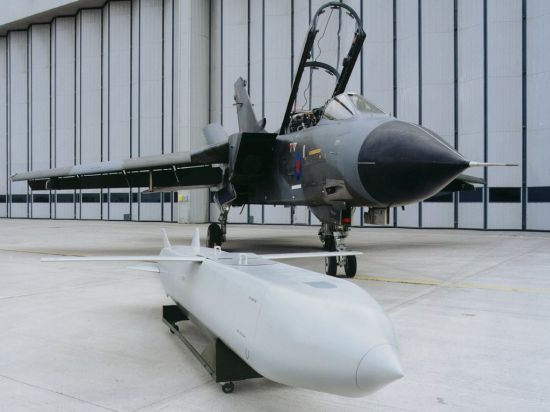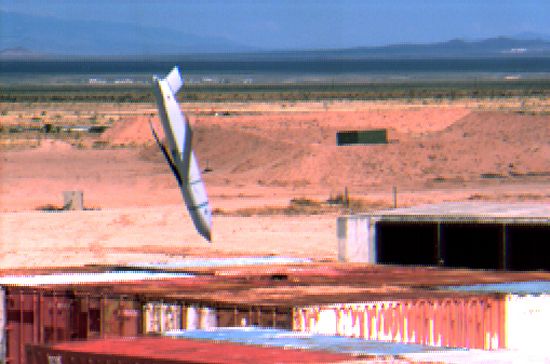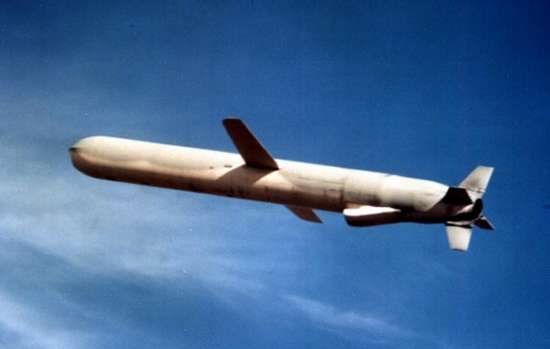|
||||||||||
|
|
||||||||||
|
||||||||||
|
|
||||||||||

The Storm Shadow entered service in late 2002 and is designed to be carried by the Royal Air Force's Tornado, Eurofighter Typhoon, and Harrier GR.7. The French SCALP EG will be fitted to the Mirage 2000D, Mirage 2000-5 and Rafale. The purpose of the weapon is to give these aircraft a long stand-off range so that they can fire a precision-guided weapon at a heavily-fortified target from far outside the range of enemy defenses.
Even though the American BGM-109 Tomahawk is a surface-launched system carried aboard US Navy ships and submarines and the Storm Shadow is an air-launched weapon, they are designed for similar missions. As a result, they are also comparable in overall size and weight. Both also employ similar flight profiles and guidance systems, although the Tomahawk possesses a much longer range.
Nevertheless, a far more comparable weapon to the Storm Shadow is the American AGM-158 Joint Air-to-Surface Standoff Missile (JASSM). JASSM is also an air-launched precision-guided cruise missile designed with stealth characteristics and incorporating a high-yield penetration warhead. The weapon is not due to enter service until 2004 or 2005, but JASSM is currently completing flight testing and will be carried aboard the Air Force's F-16C/D and B-52 as well as the Navy's F-18E/F. In the future, JASSM may also be integrated aboard other platforms such as the F-15E, F-117, B-1B, B-2, and P-3C. Note that the Navy cancelled its plans to purchase JASSM in early 2005. JASSM will not be carried by the F-18E/F or P-3.

The basic specifications for all three of these missiles are compared below.
| Specification | Storm Shadow | Tomahawk | JASSM |
|---|---|---|---|
|
Launch Platform |
aircraft |
surface ship, submarine |
aircraft |
| Length | 16.75 ft (5.1 m) |
18.3 ft (5.6 m) without booster |
14.0 ft (4.27 m) |
| Wingspan | 9.33 ft (2.84 m) | 8.8 ft (2.7 m) | 7.92 ft (2.4 m) |
|
Fuselage Width |
<3.3 ft ft (<1 m) | 1.7 ft (0.52 m) | ? |
| Weight | 2,860 lb (1,300 kg) |
2,650 lb (1,200 kg) without booster |
2,250 lb (1,020 kg) |
| Propulsion | TRI 60-30 turbofan |
Williams F107-402 turbofan plus solid rocket booster |
Teledyne CAE J402-100 turbojet |
|
Mid-Course Guidance |
Inertial, GPS, terrain matching |
Inertial, GPS, terrain matching |
Inertial, GPS |
|
Terminal Guidance |
Imaging infrared, autonomous target recognition |
Digital scene matching |
Imaging infrared, autonomous target recognition |
| Warhead |
BROACH High Explosive unitary |
1,000 lb (305 kg) unitary or submunitions |
1,000 lb (305 kg) unitary |
| Cruise Speed |
>Mach 0.8 at low altitude |
550 mph (885 km/h) at 50 to 100 ft, Mach 0.75 |
>Mach 0.8 at low altitude |
| Range | 135 nm (250 km) | 870 nm (1,615 km) | 200 nm (370 km) |
It is difficult to say whether one of these missiles is "more effective" or "more accurate" than the other. Both Storm Shadow and Tomahawk employ similar navigation methods combining inertial navigation with terrain matching and Global Positioning System transceivers that should provide equally accurate targeting ability. The Storm Shadow also uses an autonomous target recognition system for terminal guidance whereas Tomahawk uses a Digital Scene Matching Area Correlation (DSMAC) system. DSMAC compares a stored image of the target taken from high-resolution satellite imagery with the actual target image as seen by the missile itself.
Another interesing difference is the BROACH warhead concept employed on the Storm Shadow. BROACH, short for Bomb Royal Ordnance Augmenting CHarge, is actually a multi-warhead system made up of an initial penetrator charge with a secondary follow-through bomb, supported by multi-event hard target fuzing. Testing has indicated that the BROACH system is able to penetrate and destroy reinforced concrete structures more than twice as thick as those destroyed using equivalent single penetrating warheads like that carried by Tomahawk.

However, the latest Tactical Tomahawk variant carries an upgraded warhead with improved fuzing and greater
explosive power for penetrating hardened targets, plus it can travel over a much longer range than Storm Shadow.
Both systems have their advantages and disadvantages, so it is unfair to say that one is better than the other.
- answer by Jeff Scott, 20 April 2003
Related Topics:
Read More Articles:


|
Aircraft | Design | Ask Us | Shop | Search |

|
|
| About Us | Contact Us | Copyright © 1997-2023 | |||
|
|
|||